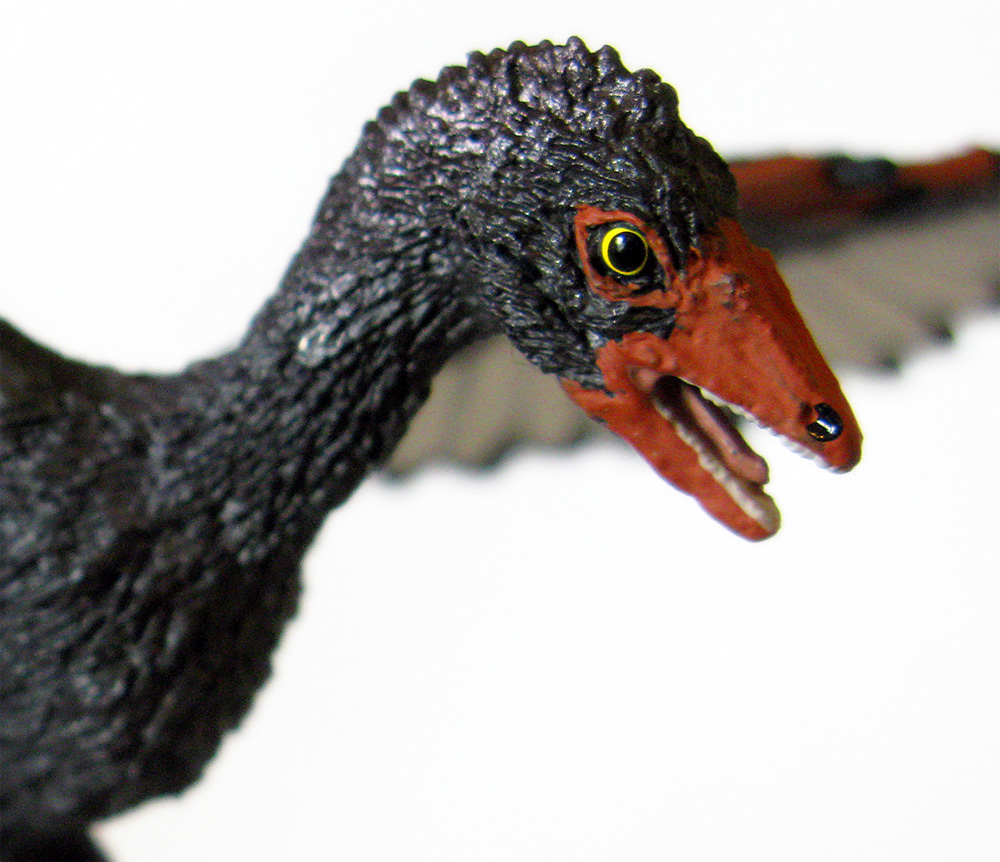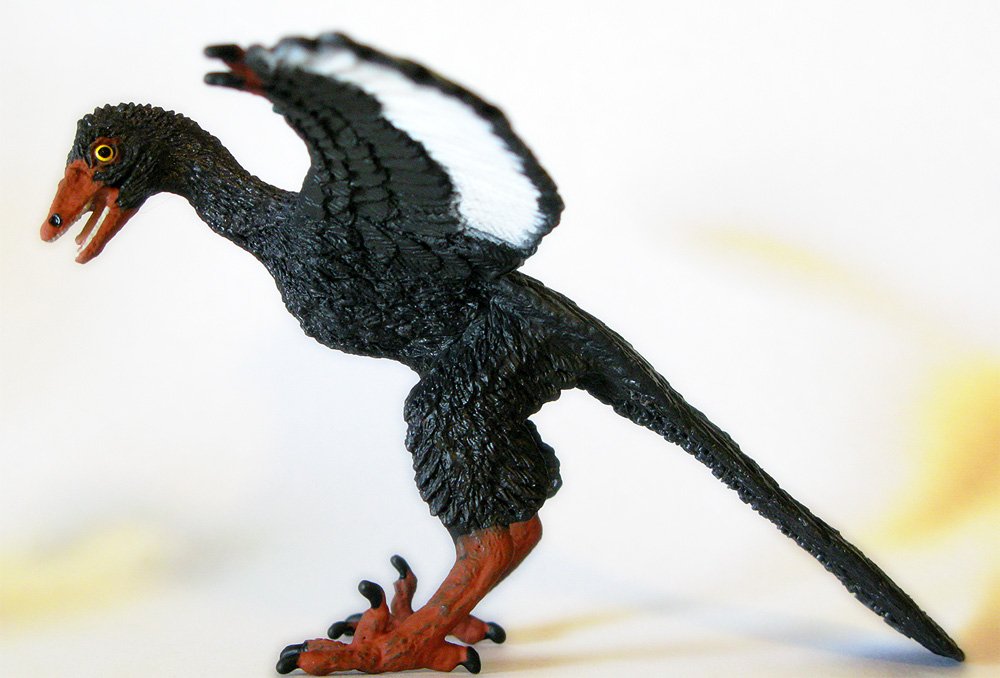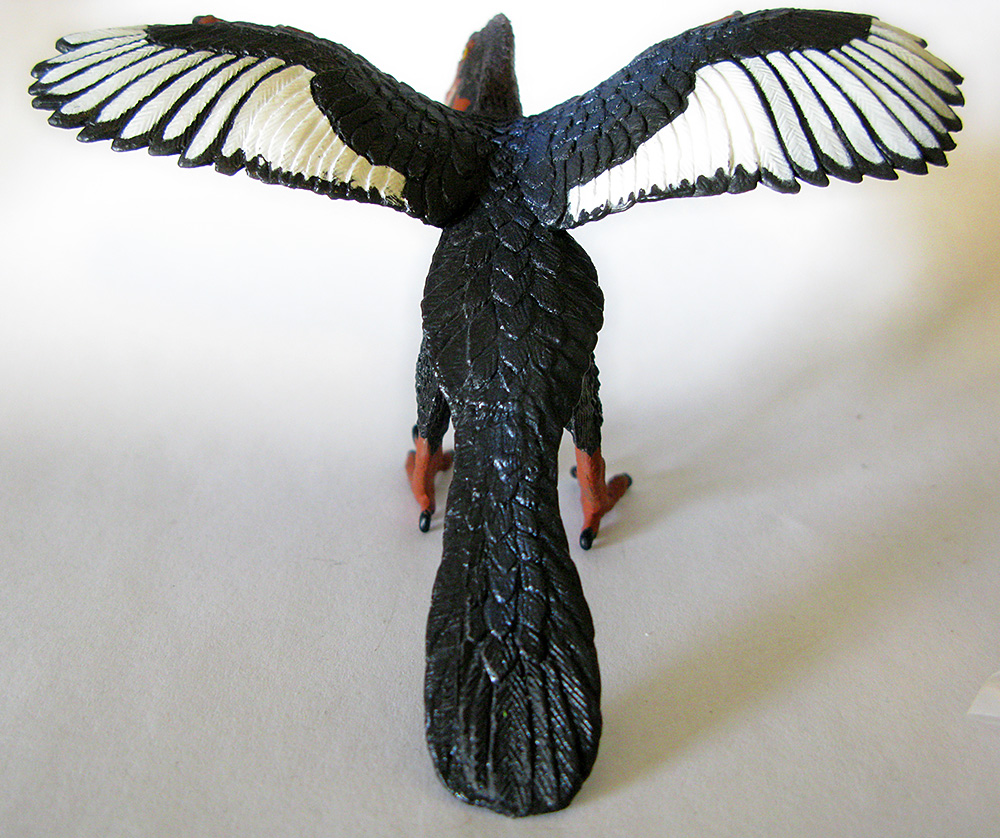Review and photographs by Patrx, edited by Plesiosauria.
Archaeopteryx lithographica, the famous “ancient wing”, was named for a single wing feather found in the Solnhofen Lagerstätten in 1861. That feather would soon be joined by more fossils, adding up to a remarkably detailed body of evidence for the creature’s shape, anatomy, and integument. Yet, somehow, popular depictions almost never seem to hit the mark. Happily, this new Archaeopteryx from Safari is here to set things right, dodging all the old “lizard-bird” tropes that we’ve seen before. Well, most of them.

As with the rest of the models from Safari this year, the details on this guy really impress. The animal is, of course, decked out in feathers. But beyond that, there are distinct types of feathers visible on different areas of the body. The head, neck, and breast bear what look like fuzzy, branching filaments which transition (a little abruptly) into “proper” contour feathers along the back, and, of course, on the limbs. The sculptor of this model, Doug Watson, cites a 2004 paper by Christensen and Bonde. The feathers on the legs are quite long, and extend to the ankles, based on N. Longrich (2006).

As expected from a model so thoroughly researched, the proportions and basic elements of the anatomy are spot-on. The wings look like wings; with correct hand anatomy instead of the bizarre “wings with hands tacked on” look that shows up all too often. There are primary feathers starting at the second finger. The skull is the correct shape and size, with accurately-proportioned eyes, tiny teeth, and a subtle pair of ridges of the kind Gregory Paul seems fond of in his Archaeopteryx reconstructions. The leg musculature is appropriate. Interestingly, the feet feature hyperextensible sickle-clawed second toes, which, while debatable, is also backed by a paper (Mayr et al. 2005).

Remember that first feather I mentioned before? The one that was given the name Archaeopteryx in 1861? In 2011, a team was able to detect melanosomes (organelles containing the dark pigment melanin) in the feather (Carney et al. 2012). They concluded that this feather had been black when the animal was living. Accordingly, this model’s feathers are predominantly painted black. It’s far from dull, however. The back of the animal has been given a subtle but lovely iridescent blue color, with a purplish glint on the head, apparently inspired by magpies. It’s a cool thing to see, particularly on a mass-produced figure. Another neat detail is the dark edge along the otherwise white flight feathers. This is seen in modern birds quite frequently – the melanin actually toughens the vulnerable wingtips. It’s also supported by yet another study (Manning et al., 2003 [pdf here])! The unfeathered portions of the animal are painted a really bright orange hue. Maybe a little too bright. I do really like the look of the eyes – vibrant and convincing. The claws are painted black, the tongue is pink, and the teeth are white; simple but effective.

So, what’s not to like? Well, the one thing that really drags this brilliant figure down for me is the pose. Wings splayed, leaning back on its tail, head turned a bit and mouth agape, I expect it’s meant as an aggressive posture. In addition to the dreaded tripod support (why no base?), it’s just not that interesting or natural-looking. It’s the same pose Archaeopteryx so often seems to get stuck with. With that said, I’ve never bought “tripod-tailed” models for my own collection, except for this one. The positive elements outweigh the unfortunate pose, in my book. The claws are also disappointingly blobby and dull, which I chalk up to toy safety concerns. Alas. There are also some design choices that ultimately come down to preference. The feathers on this model were definitely well-researched and well executed, but they’re not as dense as I’d really like to see. They’re very tight to the body, particularly around the neck. Certainly plausible (i.e. the flamingo,) but the necks of most birds are buried in feathers. I would also have liked to see feathers on the snout and digits.

There’s a lot of research behind this little bird, which is fantastic to see! If you’re a fan of maniraptorans, this is one time you shouldn’t let a tripod pose keep you from picking one up. In closing this dreadfully lengthy review, I shall say that this has been a great year for Safari, both in terms of accuracy and detail. The Carnegie line may be extinct, but, as always, Archaeopteryx is a sign of a bright and interesting future.
Available from Amazon.com here.

Disclaimer: links to Ebay and Amazon on the DinoToyBlog are affiliate links, so we make a small commission if you use them. Thanks for supporting us!




[…] the mouth, and white teeth. But the black is a dull, flat tone, not iridescent at all. Whereas the 2015 Archaeopteryx figure has a much more vibrant appearance despite the fact that it too is mostly black in […]
Maybe as a result of variations in production, my Archy is not “tripod-tailed” but is keeping its tail about 1 cm off the ground.
Great review Patrx, was this your first? Regardless, well done. One minor point though, I believe Doug said his inspiration for the feather sheen was from grackles, not magpies. A minor issue I know but one I feel Doug might like corrected.
I’ve actually penned a few others – the X Plus Styracosaurus, the Favorite 2012 Dino Expo Tyrannosaurus, and Fauna Casts Tyrannosaurus V2. The more I read them, the less impressed I am with my own writing! You appear to be correct about the grackles. Perhaps I can see to it that an amendment is made!
This all said in this great figure, their feathers are detailed to the millimeter. It is perhaps for me the best figure of Archaeopteryx to date.